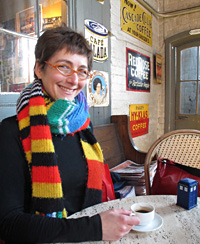A knitter asked about whether it was possible to convert all sock patterns to be worked two-at-a-time, toe up.
The key tweet was this one...
Knitters help please.. wanting to try knitting socks for 1st time... can ALL sock patterns be converted to 2-at-a-time toe-up?
— Lone Wolf (@NZLoneWolf) September 26, 2012
It wasn't directled specifically at me, but I couldn't NOT reply.
My first reply was "Why?" (The unspoken follow-up being" "Are you trying to kill yourself?")
Two-at-a-time toe-up is so not where I would start a new sock knitter, no matter how experienced or talented. I like working toe-up socks, and I find two-at-a-time very amusing, but the start of a toe-up is pretty fiddly for a new sock knitter,and then to compound that by having to keep track of two socks and two yarns... well, it just seems less than fun.
The entirely reasonable reply was that the knitter had been told that toe-up gives you a good way to try the sock on as you go.
Aha, I said! AHA!
This is one of my favourite myths about sock knitting: that there's no meaningful way to try on a top-down sock as you go. Not true!
After all, the sock typically has the same number of stitches in the leg as the foot (given that most people's ankle circumference is pretty close to their foot circumference), so you can put the leg on your foot to check fit. Easy!
And related myth: there's no way to adjust a top down sock foot. Equally not true!
You can try the sock on again after you've turned the heel and you're working the gusset decreases. And you can adjust the fit of the foot by working more (or fewer) gusset decreases. Easy.
And it's actually easier to get the foot length correct for a top-down sock than a toe-up.
Controversial Opinion Alert!
Really. I'll say that again.
IT IS EASIER TO FIT THE FOOT OF A TOP DOWN SOCK THAN A TOE UP.
Here's the thing: to get the foot length right in a toe-up sock, you need to start the heel at the right place. And to start it at the right place, you need to know how long the heel turn is, and then start working the heel that distance short of foot length. Thing is, I haven't seen many toe up sock patterns that explicitly state that length.
So it's often a guess, or a vague instruction about placement on the foot, or worse, a set length (e.g. 'work foot until sock measures 6 inches, then turn heel'). And if you get it wrong, you've got a fair bit of knitting to undo, and it can be tricky knitting to redo.
It's more common to see a top down sock pattern that tells you when to start the toe(usually, 'work foot until it measures 2 inches short of full foot length'). And if it turns out you've messed it up, there's less knitting in a toe (and it's usually more straightforward), so it's less painful to undo and rework.
To the intrepid knitter on Twitter, I suggested a "walk before you run" approach. I strongly believe that a top-down sock is easiest for a new sock knitter, as you get a chance to build confidence with the tiny yarn and tiny needles working on a set number of stitches in the leg, before you have to start worrying about the tricky stuff. With a toe-up sock, you're immediately thrown in the deep end: you start with a small number of stitches (which is trickier) and straight away have to start shaping the toe.
Once you've mastered top-down, then try toe-up, and then when you're comfortable with toe-up, try two at a time. I also strongly believe a knitter should try both styles to see which construction they enjoy more - and which fits better. They don't fit the same, and feet can vary wildly.
(Totally new to sock knitting? Start here, with my Top Down Training Sock! And if you're ready for toe up, here's the Toe Up Training Sock!)








